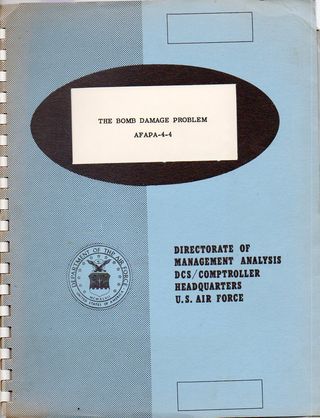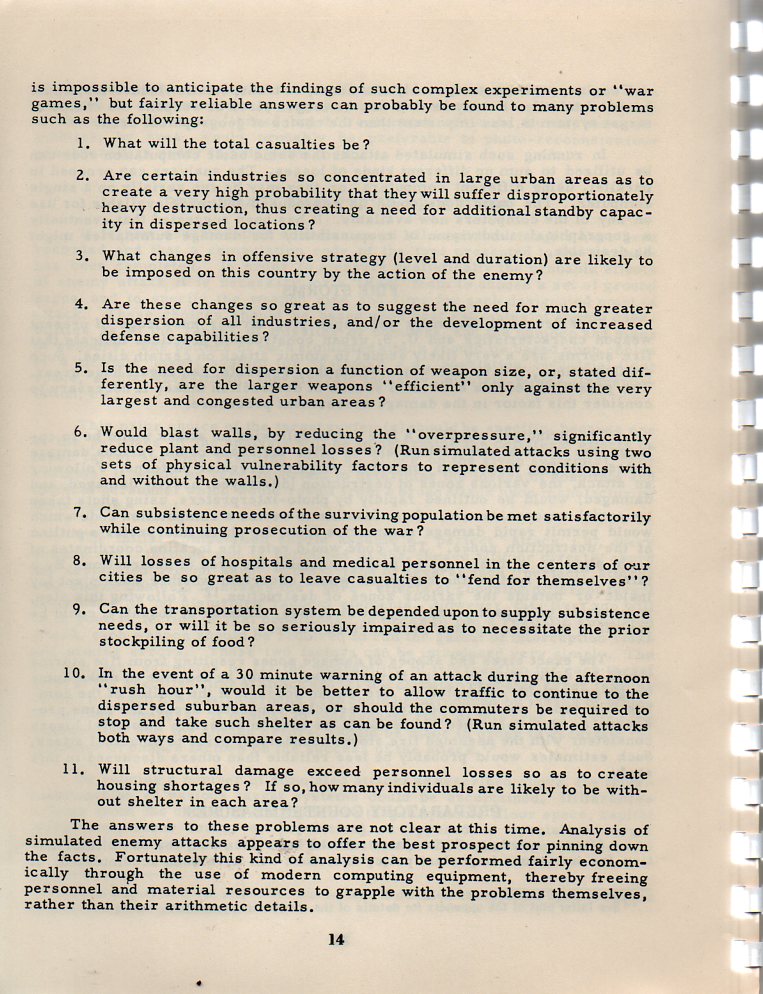JF Ptak Science Books Post 2401
[Original document available from the blog's bookstore.]
The spoiler answer to this: make sure to account for the nukes dropped on you when figuring out what you've got left to work with.
ITEM: The Bomb Damage Problem, AFAPA-4-4, published in 1954 by the Directorate of Management Analysis (DCS/Comptroller at the Headquarters of the U.S. Air Force). 11x8 inches. GVC binding. 22pp. Very good condition. RARE. No copies located in WorldCat. $175.
This seems a tautologically tongue-twisting, not-quite-right title for this post, and indeed it might be. But that's the way the pamphlet I'm reporting on read, a sometimes resilient-to- inspection rubberie beastie whose basis for being written was to report on an great oversight that doesn't really want to be recognized, even if it is the title of the work.
The Bomb Damage Problem, AFAPA-4-4, published in 1954 by the Directorate of Management Analysis (DCS/Comptroller at the Headquarters of the U.S. Air Force) is a pamphlet of discovery–or rather, the discovery of the lack of discovery.
The work is an introduction to some aspects of nuclear exchange post-attack predictive capacity–particularly with the ability of American industry “to support a war plan”.
The anonymous pamphlet gets straight away to the discovery part–that previous predictions of post-attack capacity were “probably completely unrealistic” because “[they] did not take account of the likely bomb damage to the U.S. production facilities”.
I would think that even at this relatively early point of planning for possible Soviet nuclear attack that war game scenarios would have taken bomb damage to industry a”and accompanying manpower losses” into account of how the war machine would react after the bombs began to explode. Though it seems not. I’ve looked to see how I could be misreading this thing because it seems like too monumental an oversight to make. But I can’t find where I’m making my interpretative mistake.
Ultimately the authors focuses on saving the corpus of the overall works, saying that this oversight does not damage the “important thinking” that had gone on it spite of this error.
The word “error: is not used in the text of course. This is how it is described: “In connection with this critical new obstacle to intelligent military planning, it is essential that speculation be minimized.” The error is actually redefined as a “critical new obstacle” the effect of which heightens “speculation”. Which is all true.
I suppose what is really going on his the formation of some bedrock stuff formulating information gathering for creating a computer program for deeper analytical study of the effects of nuke warfare on post-attack industry. 1954 is about right for the time for this to happen, and the DMA–as the home for the creation of linear programming among countless other things–would’ve been the place for this work to happen.
But I keep coming back to what seem to be enormous understatements–even giving plenty of allowance for the time–that keep cropping up in the pamphlet. Perhaps it is just stating the obvious for te first time that makes all of these seem so potentially underwhelming, like this nugget: “numerous measures of the importance of each target may eventually be needed....” (Page 7).
There’s plenty of more detail though that occurs in the pamphlet, as in figuring out damage to structures by the yield of the explosion and distance from the target and the composition of the target’s structure, and so on.
And then we get back to the obvious: “the principal effect of a fire storm following an attack would be to enlarge the area of destruction and to alter the shape of the various damage zones, changing them from concentric rings to irregular patterns. “. As I said, maybe it is just a case of a “Call me Ishmael”, or stating that lines and points in space exist for the purpose of geometry. Still, it rubs me the wrong way, all over.
And just to make this point perfectly clear: the "bomb damage" problem is to take into account bomb damage to U.S. war-making, bomb-producing capacity, in a sort of BIBO (bomb in, bomb out) version of a SISO (shit in, shit out).




Comments